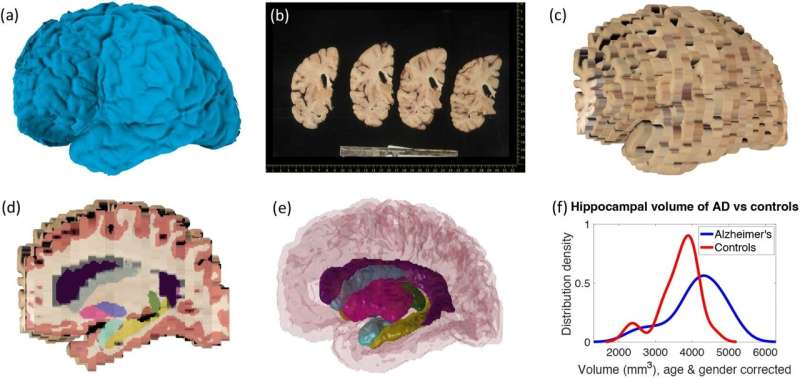
Examples of inputs and outputs from the MADRC dataset. Credit: (2023). DOI: 10.7554/eLife.91398.1
Researchers have developed a suite of free tools for analyzing vast amounts of brain dissection photographs at brain banks worldwide to enhance understanding of neurodegenerative diseases.
The study, published today as a Reviewed Preprint in eLife, is described by the editors as providing a valuable open-source tool for researchers in the neuropathology and neuroimaging field, supported by convincing evidence from experiments using both real and synthetic data.
Measuring the volume of different brain regions is an important way to understand aging and neurodegenerative diseases and is usually carried out either by using a magnetic resonance imaging (MRI) scan in people while they are alive or by studying sections of brain tissue donated to brain banks after death.
Being able to link the results of microscopic tissue analysis with large-scale macroscopic data from MRI scans is invaluable, but MRI scans are usually obtained from patients many years before they die, making it difficult to link what is seen on the scan with what is later seen under a microscope.
An alternative to this is to take an MRI scan of the brain following post-mortem and before tissue sections are taken for microscopic analysis. However, few biobank centers have the equipment or expertise to do this. Instead, quantitative measurements such as cortical thickness and atrophy of specific regions are often estimated qualitatively by researchers looking at brain slices.
“We set out to propose a solution to this problem by leveraging routinely acquired dissection photographs of brain slices before microscopic analysis,” explains lead author Harshvardhan Gazula, Postdoctoral Research Associate at the Athinoula A. Martinos Center for Biomedical Imaging at Massachusetts General Hospital (MGH), Massachusetts, US.
“These vast collections of dissection photographs present an invaluable and currently under-used information resource, which holds the promise of advancing our understanding of various brain functions and disorders.”
Harshvardhan and colleagues have developed a suite of computational tools that will allow other researchers to use these dissection photographs to reconstruct a 3D picture of the brain. The suite is freely available and has three modules: the first corrects for different perspectives and pixel sizes in the original images; the second builds a 3D reconstruction of the brain from the photos, using a 3D brain surface scan or generic brain atlas as a reference point; and the third module then segments the brain reconstruction into different brain regions—such as the hippocampus, thalamus, and cortex.
The structure and volumes of these regions can then be compared with other MRI scans and used alongside the microscopic data to learn more about changes that occur in neurodegenerative disease.
To assess the accuracy of the tools, the team carried out three validation steps. First, they used their tool to analyze dissection photographs from 21 post-mortem confirmed Alzheimer’s disease cases and 12 age-matched control brains. This showed that the model captured well-known patterns of Alzheimer’s disease, such as shrinkage (atrophy) in the hippocampus and enlargement of the brain ventricle.
Next, they compared the accuracy of the new tool with the current gold-standard analysis method, which employs a different technique for the segmentation step. This showed that the new tool outperformed the older version in several ways: for example, it was more effective at filling in missing information between brain slices.
Finally, the team evaluated how robust the algorithms are at reconstructing the brain across a large, variable set of data simulated from MRI scans from a further 500 participants. This showed that the method was reasonably robust even when there was more spacing between brain slice images, but it also showed that consistency in the thickness of brain slices is important for accuracy.
This study comes with a few limitations, including the fact that the method can only segment the whole cortex and is currently unable to subdivide it into regions—a task known as ‘cortical parcellation.’
Accurate cortical parcellation would be of interest because the morphometrics of individual regions—specifically, measurements of their thickness—are more predictive of neuropathology. The authors say they are now looking to extend the toolset to allow for cortical parcellation in the future.
“Leveraging the vast amounts of dissection photographs available at brain banks worldwide to perform morphometry is a promising avenue for enhancing our understanding of various neurodegenerative diseases,” concludes senior author Juan Eugenio Iglesias, Associate Professor of Radiology at the Athinoula A. Martinos Center for Biomedical Imaging at MGH.
“Our publicly available tools are easy to use by anyone with little or no training and enable a cost-effective and time-saving link between morphometric phenotypes and neuropathological diagnosis. We expect these tools to play a crucial role in the discovery of new imaging markers to study neurodegenerative diseases.”
More information:
Harshvardhan Gazula et al, Machine learning of dissection photographs and surface scanning for quantitative 3D neuropathology, eLife (2023). DOI: 10.7554/eLife.91398.1
Journal information:
eLife
Citation:
New computer tools can reconstruct 3D brain from biobank photos (2023, December 12)
retrieved 12 December 2023
from https://medicalxpress.com/news/2023-12-tools-reconstruct-3d-brain-biobank.html
This document is subject to copyright. Apart from any fair dealing for the purpose of private study or research, no
part may be reproduced without the written permission. The content is provided for information purposes only.
>>> Read full article>>>
Copyright for syndicated content belongs to the linked Source : Medical Xpress – https://medicalxpress.com/news/2023-12-tools-reconstruct-3d-brain-biobank.html
